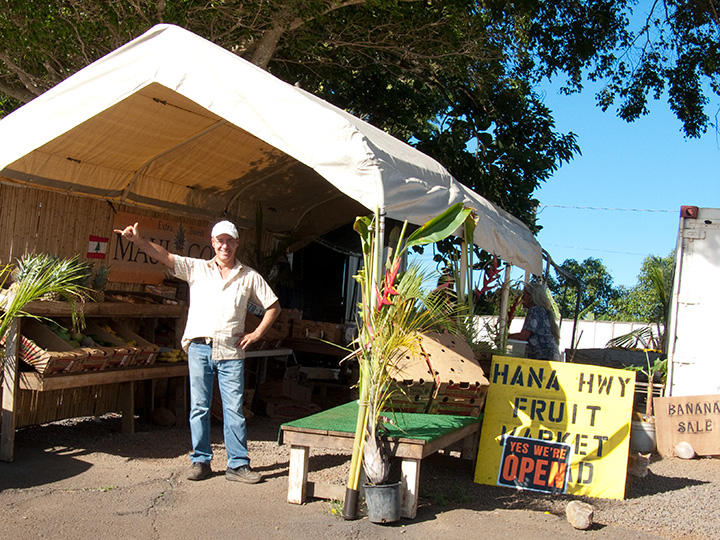While it’s been grown in Hawaii for at least a decade, rambutan is still somewhat new to the islands. It’s a fruit that’s related to the lychee, distinguished by its oval shape and red rind covered in hairlike bristles.
The fruit comes from the Malay peninsula, and its name is derived from the Malay word “rambut,” which means hair.
Rambutan season is during the winter months, a nice counterpoint to the summer lychee season. The flesh is white, translucent and grapelike in flavor, perhaps not as juicy as a lychee, but certainly reminiscent of its sweet-tart flavor.
Rambutan are grown mostly on the Big Island, and much of it is exported to ethnic markets on the West Coast. Look for rambutan at farmers markets and Chinatown stores. As trees have matured in recent years, the fruit has become more delicious.
To eat a rambutan, use a small knife to cut through its equator and remove the spiny shell. Just pop it into your mouth and discard the seed. This fruit is a good source of vitamin C and refreshingly delicious.
Stevenson’s Library’s ‘Lychee Pomegranate Martini’ recipe
After years of sipping cocktails that were either too sweet or too sour, it was wonderful to finally experience one that’s just right.
At the Grand Hyatt Kaua‘i Resort & Spa in Po‘ipu, Stevenson’s Library bartender Baren Pimsaguan has mastered the fine art of the martini during his six years behind the polished, 27-foot koa wood bar that surrounds a spectacular assortment of cognac, brandy, scotch and cordials.
His refashioned lychee pomegranate martini is a dangerous drink because its delicate and subtle flavors mask this cocktail’s strength. One is fun, two is woo hoo. Be careful of that kick — oh, and the bill. This specialty concoction will run you $14.
But at Stevenson’s, you can also enjoy free pool, backgammon, chess, live music nightly, the country-club-style decor and the atmosphere of a true five-star resort.
Hana Highway Fruit Market

Creative entrepreneurial efforts deliver Maui Agricultural products directly into the hands of the neighborhood community and also tourists traveling to Hana. In addition to traditional items such as Maui Gold Pineapple, banana, and avocado the Hana Highway Fruit Market provides exotic fare such as loquat and lychee.
HAWAII FRUITS ANNUAL SUMMARY
Here is the PDF file for the HAWAII FRUITS ANNUAL SUMMARY Report.
Please visit the website for more information: http://www.nass.usda.gov/hi/
————————————————————-
Contact Information:
Mark E. Hudson, Director
USDA NASS Hawaii Field Office
1421 South King Street
Honolulu, HI 96814-2512
Office: (808) 973-9588 / (800) 804-9514
Fax: (808) 973-2909
————————————————————-
2006 HAWAII FRUIT OUTPUT AND VALUE DECLINE
Hawaii fruit growers harvested 435.2 million pounds of fruit for fresh and processed utilization in 2006, an 11 percent decline from the previous year, according to the USDA, NASS, Hawaii Field Office. Total value fell 3 percent to $101.7 million, with guava, lemon, papaya, pineapple, and the tropical specialty group recording declines in value of sales. Fruit acreage totaled 19,740 acres, a 2 percent decrease from 2005. Harvested area decreased 6 percent to 4,090 acres. Almost continuous rainfall from late February through March contributed to losses in some crops due to soil erosion, flooding, disease outbreaks, and fruit and tree losses. The lengthy rainy period slowed fruit maturation in some crops.
Pineapple, still Hawaii?s largest fruit commodity, represented 70 percent of total fruit acreage and 74 percent of the total fruit value. Total utilized pineapple production fell 11 percent to 376 million pounds. Since records were kept by the Hawaii Field Office, 2006 was the first year fresh market utilization outweighed processed utilization. Also establishing a record was the average farm price. In late 2006, operations ended prematurely for one major company which had previously announced their phase-out of pineapple production.
The state?s papaya producers devoted 2,095 acres toward papaya production, a decrease of 13 percent from the previous year. Harvested area totaled 1,530 acres, 3 percent more than 2005. Papaya output declined 13 percent to 28.7 million pounds while value of sales dropped 2 percent to $11.0 million.
Total banana acreage rose 5 percent in 2006 while harvested acreage increased 2 percent to 1,000 acres. Utilized production was pegged at 20.0 million pounds, 4 percent less than 2005. However, higher average prices helped push total value of sales to $9.8 million, 7 percent higher than the previous year.
Total guava production area declined 14 percent to 575 acres in 2006 while area harvested declined 41 percent to 365 acres. Value of sales declined 7 percent to $1.1 million. Hawaii?s guavas, which are mainly for the processed market, recorded a 2 percent increase in price. However, this was not enough to offset the 9 percent lower output.
Area devoted to tropical specialty fruit totaled 1,240 acres in 2006, 2 percent less than 2005. Area harvested totaled 690 acres, 5 percent lower than the previous year. Hawaii?s growers of tropical specialty fruit produced and sold an estimated 1.45 million pounds of fruit in 2006, relatively unchanged from 2005. Compared with 2005, higher output was registered for longan, lychee, mango, and persimmon. Value of sales was pegged at $2.6 million in 2006, 4 percent lower than 2005.

